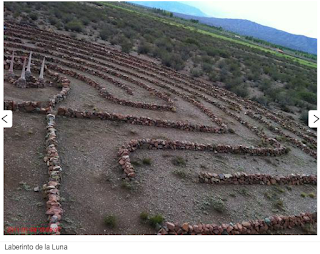I wrote to a hotel which is 1,200 m south (3/4 of a mile) from the Labyrinth and asked them if they knew about it. They were kind enough to write and explain:
Buenos días , lei su consulta . el lugar , es un museo a cielo abierto perteneciente al escultor fausto marañon . la figura del laberinto fue realizada por su hija , Yamila marañon . mas info www.pukarainca.com , atte Sergio slobodianiuk geógrafo.
Translation
Good Morning, I read your enquiry. The place, is an open air museum belonging to the sculptor Fausto Marañon. The labyrinth shape was done by his daugher, Yamila Marañon. More details www.pukarainka.com [he was promoting his hotel], Regards Sergio Slobodianiuk geographer.
I immediately googled her name and came across her website and a page dedicated to her mazes, it has photos of the one that I had spotted with Google Earth: her web is http://www.yamyla.com.ar/p/laberintos.html
I felt a bit let down... I had thought that I had discovered - uncovered something new, but, it was very like a cretan maze and I had not found any references to Inca mazes with that shape. So, it was not an Inca maze at all. (if it looks like a dog and barks, it is a dog... if it looks like a Cretan maze it is one (and therefore it is modern).
On the bright side my conjecture about low walls was on the mark.
I will leave my Google Earth armchair exploration and focus on the possible arrival of pre-sapiens humans in America. So I am preparing a post on primitive stone tools in South America (prompted by some information and some bright remarks that Pablo Infantino shared with me (Thank you Pablo).
Patagonian Monsters - Cryptozoology, Myths & legends in Patagonia Copyright 2009-2013 by Austin Whittall ©

















No comments:
Post a Comment